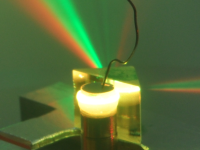Our fields of research
Materials Research
We are particularly interested in non-centrosymmetric crystals because these are able to show particularly strong nonlinear optical effects. Here, light can influence the optical material properties in such a way that this has a noticeable effect on the light wave itself. We are exploring the properties of a wide range of substances. This enables us to realize nonlinear optical systems from the ultraviolet to the long-wave infrared spectral range. An important topic is the structuring of ferroelectric domains, which is necessary to build optical frequency converters. By means of calligraphic poling with the help of an electrically charged metal tip we can create domain structures of almost any type. We also explore the electric and optical properties of the domain walls. Another important area is the optical transparency of the materials, which is often limited by defects. We can still measure losses even as small as in the ppm range and have the goal of identifying the cause of the losses and then specifically minimizing them. |
|
 |
Optical Whispering Gallery Resonators
| Whispering gallery resonators are rotational symmetric monoliths made of dielectric materials. In them, irradiated laser light is guided on a circular path by total reflection. Although they only have diameters in the (sub-)millimeter range, the circulating light can propagate effectively up to several kilometers. In addition, the power of the laser light is increased by several orders of magnitude. This opens up a wide range of applications in sensor technology and nonlinear optics. We manufacture these unique cavities as bulk resonators or chip-integrated from various crystalline materials. We use them for materials research as well as for the realization of miniaturized lasers and optical non-linear frequency converters. |  |
Lasers
With the help of whispering gallery resonators we develop and research miniaturized solid-state lasers. These do not require any dielectric coatings or mirrors. The resonators used are doped with laser-active ions such as erbium, neodymium or praseodymium and can be pumped with LEDs in some cases. Even without additional frequency-selective elements, we achieve stable single-frequency operation and mode-hop free tuning of the emission wavelength. |  |
Optical Frequency Converters
Optical frequency converters - especially optical parametric oscillators (OPOs) - can be used to cover spectral ranges that are difficult or impossible for lasers to reach. In principle, light of any wavelength can be generated with an OPO, as long as it is higher than that of the irradiated laser light. In terms of wavelength flexibility, an OPO is therefore far superior to a laser. We study and realize miniaturized whisper gallery based optical parametric oscillators from the visible spectral range to the mid-infrared at a wavelength of more than 8 µm. The oscillation thresholds are in the micro and milliwatt range, and conversion efficiencies exceed 50 %. Cascaded processes are also basically suitable for generating frequency combs with very high potential for spectroscopy. |  |


